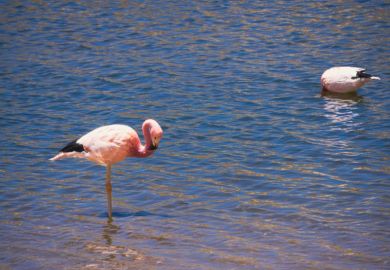A degraded plateau in Provence, another desert in deforested Amazon, a blasted marsh in Ukraine, all fallen far, the price of progress. Such it seems is the inevitable flight of time’s arrow. First axe, then chainsaw, at nuclear cathedral careless tests, all fire and flame, the end of ecology, the extinction of species. Yet loss forges other parables. Jean Giono’s hero transformed landscapes in The Man Who Planted Trees, and back came plant and bee, animal and people. In Wim Wenders’ award-winning film The Salt of the Earth, Sebastiāo Salgado turned hills to singing forest, such transformation that local weather patterns changed, bringing rain. Chernobyl’s hinterlands abandoned now for 30 years have grown up, hidden human harm, brought wolf and bear, boar and beaver, stork and eagle. This is the age of extinction, but things can get better.
In this fascinating book, Chris Thomas examines our human relationships with nature, bad and good, and sets out a “more hopeful truth” to current narratives and alarms. Climate change, ocean acidification, invasive species: all happening, yes; all provoking the sixth great species extinction, the fifth having seen off the dinosaurs. Yet this is a book about how nature is thriving in an age of extinction; outcomes hinge, of course, on our attitudes to species, our preferences that lead to actions. There are ecological absolutes, long periods necessary for speciation, quite clearly fewer tigers today. There are modern processes too, blink and the heat has risen a degree, or two.
In the 1800s, Richard Deakin catalogued 420 plant species on the Colosseum in Rome; now it has been cleaned up to be a proper ruin. When the dusky seaside sparrow of Florida was downgraded to a subspecies, federal funding for its conservation was removed. The last five were caught and kept in cages, hoping for breeding success, but all were male. Will anyone campaign to save a subspecies? The last dusky sparrow died in 1989. Here in Britain, we seemed not to care for the house sparrow when abundant, but alarms rose as numbers fell. Who, after all, killed Cock Robin with his bow and arrow? Now many studies and research projects seek answers. And here is another tale, says Thomas, “huge numbers of species are thriving in the human-altered world, and we may even be stimulating the mass diversification of new species”.
This is a rich and timely tale, fearless too, with examples and cases drawn from ecosystems across the world. Around us are world travellers, harlequin ladybird winged metre by metre from Asia, poppy as contaminant of grain carried from continental Europe, ruddy duck that flew and stayed, and is now ruthlessly hunted down. There are many small messages of gains and losses, and perhaps one huge one: that ecosystems always change, that species come and go, and that our preferences determine what we think of as good or bad. And things can get heated. To some, liking an invasive or introduced species is heresy, not dissimilar to challenging the risks of smoking or the benefits of vaccination. At some point, though, an introduced species becomes native, eliding from bad to good. The Romans brought sweet chestnut to Britain 2,000 years ago; this seems long enough to qualify as native. The sycamore was added to the British flora only 500 years ago, and is still frowned upon. Rhododendron was brought to Britain in 1763, and condemned once it leaped the garden wall. Himalayan balsam, with startling pink flowers and popping pods, was imported in the 1830s, and is still hated, chopped and cut by active conservation parties.
But then natural selection gets to work, over time often producing new species. Yellow-flowered Senecio were first collected from volcanic Etna, brought to Oxford Botanic Garden, and escaped soon by wind-blown seed. First the walls and gravels of city colleges were ideal habitat, and so emerged the Oxford ragwort. Then were built new railway lines, iron rails laid on lava-like crushed ballast, and off went the ragwort, sucked along by train and carriage. And now emerge groundsel hybrids in York, Wales, Edinburgh. The Department for Environment, Food and Rural Affairs has a ragwort code: you must cut or spray or pull. Myths are many: it is horse slayer, cattle killer, symbol of farming decay. It is a notifiable weed, toxic, a bad plant. But official weed or not, preferred extinction creates a problem. Thirty species of insect depend exclusively on ragwort; another 22 eat much in their diet. It is a pollen source for butterfly, moth, bee and beetle. Thus, kill or leave?
Arrivals provide opportunity: for insects to eat, disease to infect, bird and lizard to find new prey. Take the apple fly, first infesting North American domestic apples from a century ago. The apple fly, though, was once a hawthorn fly, eggs laid on hawthorn berries and larvae feeding inside the fruit. Now, though, the apple fly has evolved to prefer the smell of apple, and hawthorn fly only the smell of hawthorn. This keeps them apart, and genetic isolation will result in a new species. And this is not all: three species of parasitic wasp feed on these flies. Historically, the wasps were attracted to hawthorn smell too, but now are repelled. They too prefer apple odour so that they can find their prey. Four insect species, a fly and three wasps, are in the process of turning into eight. The introduction of apple did this.
Let us finish on wolf controversy. Few people have seen a wild wolf, yet they dominate imagination. Many people today love wolves, many hate them. They walk in fairy tale, Little Red Riding Hood, Three Little Pigs, and inside common idiom: we are hungry as a wolf, or try to keep the wolf from the door. Early settlers to North America carried practices of wolf extermination with them, and worked hard at it. In Montana, 80,000 wolves were killed by bounty hunters in 35 years. In Ontario, wolf bounty was not repealed until 1972. Many wolves were called outlaws, appearing subject to the same laws as people. Some attained legendary status, Old Lefty of Colorado, Three Toes (13 years on the run), White Lobo of Texas. Now, all change, wolves have been reintroduced to great ecological success in Yellowstone National Park. Thomas describes the seemingly inevitable fate of the Ethiopian wolf, only 200 adults high in the Bale Mountains. At low altitude they are in conflict with people and, worse, catch dog-borne rabies and distemper. As climate change forces habitats upwards, the wolves go up too. They will soon have nowhere to go.
The only irritants in this book arise from language and style. We do not, it feels to me, need to know that a location was visited on a holiday trip, nor need every verb describing animal behaviour to work so hard: must catfish gobble up, butterflies jostle, butcher-birds shred their victims, raccoons prowl? It is a stretch to imply that wolves are happier in certain habitats, especially when eating their evening snacks. “I thought it would last my time,” wrote Philip Larkin in Going, Going , guessing that the wild might return. But then “that will be England gone, the shadows, the meadows, the lanes…” In our shadow occurs a great species extinction; at the same time, there is another story of thriving nature.
Jules Pretty is professor of environment and society, University of Essex, and author of The East Country: Almanac Tales of Valley and Shore (2017).
Inheritors of the Earth: How Nature Is Thriving in an Age of Extinction
By Chris D. Thomas
Allen Lane, 320pp, £20.00
ISBN 9780241240755
Published 6 July 2017

The author
Chris Thomas, professor of biology at the University of York, was born in Surrey and grew up in Sussex and Dorset “before migrating to [his] current home, Yorkshire, via the US, Costa Rica and New Zealand”.
He honed his “enthusiasm for natural history”, he says, “in the fields and woods – now a housing estate – that surrounded my home in Sussex, under the tutelage of my mother”. His interest in ecological issues arose from “childhood reading of the books of Gerald Durrell, plus regular trips to London Zoo, which made me realise how fast species were disappearing”.
At university in Cambridge, Thomas “more or less ignored what I was supposed to do. I went to the lectures that sounded interesting, regardless of whether I was to be examined in them. I also spent my time taking part in extracurricular field trips, became involved in the Cambridge Bird Club, and organised summer research ‘expeditions’ to study butterflies and hummingbirds in Central America…the breadth of experience that I carved out for myself has stood me in good stead since.”
So what has led Thomas to take a more positive view of current trends than many other researchers working in his field?
“A majority of the species that I have studied have in some way been successful in adjusting to the human-altered world,” he replies.
“For the best part of 30 years as a researcher, I still framed most of these changes as negative, regarding them as further evidence of how much humans were perturbing the biological world. But eventually I started to wonder whether all the small changes that allowed species to survive in the human-altered world might add up to a bigger and more positive picture.”
Matthew Reisz
POSTSCRIPT:
Print headline: Despite us, life does go on
Register to continue
Why register?
- Registration is free and only takes a moment
- Once registered, you can read 3 articles a month
- Sign up for our newsletter
Subscribe
Or subscribe for unlimited access to:
- Unlimited access to news, views, insights & reviews
- Digital editions
- Digital access to THE’s university and college rankings analysis
Already registered or a current subscriber?




